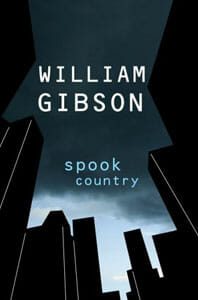William Gibson

The Future is Now: William Gibson unplugged. Kinda.
“See-bare-espace… it is everting,” William Gibson speaks through a French art dealer early in Spook Country. Enunciated so cutely, the phrase simultaneously establishes Gibson’s premise, casts a sweet nostalgia on the term he coined in 1984’s Neuromancer, partially repudiates his original usage, and hints at his ninth novel’s greatest flaw.
The 59-year-old post-cyberpunk visionary predicted the future accurately in his Nebula/Hugo/Dick-winning debut. In it, however, a good deal of the dramatic tension was created when data jockeys rushed to find ports to jack in. Spook Country, set in a specifically dated present (starting February 2006, to be exact), is a bit more wireless. In reality, cyberspace is everywhere, “everting,” users on-grid even if they flee the screen to curl up somewhere and read words printed on tree meat.
Gibson’s plot uses this notion of geo-locative representation to tap into the core paranoia of the American mood. There is international techno-intrigue involving money laundering, a family of Russian-speaking Chinese-Cuban émigrés, a scholarly pill popper, a shadowy operative from a nebulous government agency, and a few chases during which guns are fired. The gadgets are reduced to talismanic props. Really, it’s a thriller, albeit wicked smart and way funny. “Virtual reality?” asks protagonist Hollis Henry, “she hadn’t heard the term spoken aloud in years, she thought, as she pronounced it.”
The plot, bundled beneath layers of conspiracy and withheld back-story, is an excuse for Gibson to do what he does second best: be a cultural observer. He compares Elvis sightings to Tibetan mysticism, for example, and notes that a set of office furniture “had the down-at-heels look that came of having been purchased for some subsequently failed start-up, seized by deputies, auctioned, resold.” As a chronicler of the new, weird America, Gibson is peerless.
But the means Gibson uses to access these observations feel either too deliberate, or too little of a stretch: a protagonist/journalist writing for “a European version of Wired,” owned by an organization (the same that funded coolhunting Cayce Pollard in 2003’s Pattern Recognition) with a bottomless bank account and access to the absolute cutting edge.
“The street finds its own uses for things,” Gibson wrote in his 1982 short story “Burning Chrome,” defining the gritty noir that occupied most of his work through Pattern Recognition. While the street still has its say in Spook Country, Gibson now proclaims, “something that tends to happen with new technologies generally [is that] the most interesting applications turn up on the battlefield, or in a gallery.” (Convincing characters to make fascinating observations isn’t difficult when one is a reporter and the other a conceptual artist.)
-

-

-

-

-

-

-

-

-

-

-

-

-

-

-

-

-

-

-

-

-

-

-

-

-

-

-

-

-

-

-

-

-

-

-

-

-

-

-

-








































